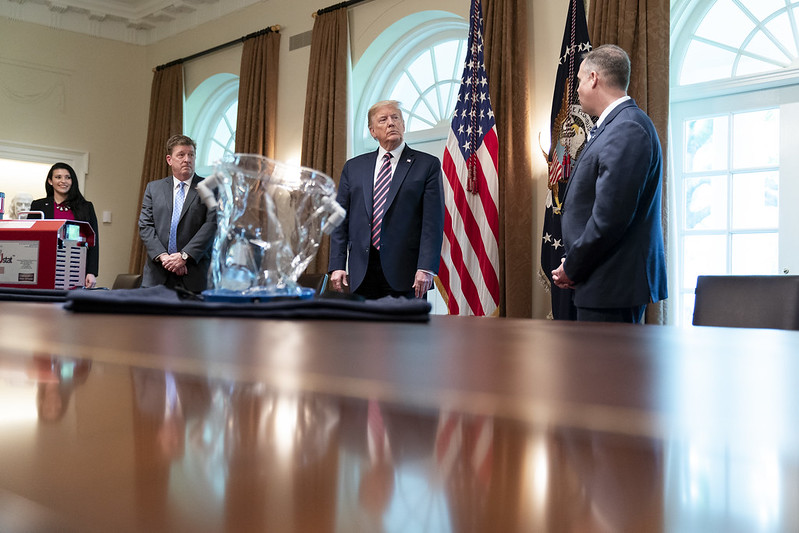Trump checks out new NASA technology to fight coronavirus pandemic

President Donald Trump inspected new technology developed by NASA to help fight the coronavirus pandemic and its associated respiratory disease, COVID-19, on April 24.
NASA Administrator Jim Bridenstine brought an oxygen hood, a sterilizing device and a ventilator to the White House to show Trump how the agency is working to support the pandemic response. The U.S. has nearly 1 million confirmed cases of COVID-19, which has killed nearly 55,000 people in the country so far, according to data compiled by Johns Hopkins University.
"The question is, what do you do with rocket scientists when they stay at home?" Bridenstine told Trump. "Well, what they do is they build amazing things."
Related: Full coverage of the space industry and the new coronavirus
Bridenstine had brought with him three examples of technology that agency employees have been developing in the six weeks or so since the pandemic entered the U.S. in earnest and the four weeks since the agency launched the NASA @ WORK program to crowdsource its pandemic response activities.
Typically, engineers at NASA's Armstrong Flight Research Center in California work on technologies related to aircraft; lately, some have instead developed an oxygen hood in partnership with commercial suborbital spaceflight company Virgin Galactic. The new device provides the oxygen pressure COVID-19 patients require while protecting healthcare workers from infection, Bridenstine said.
Another technology on display builds on NASA's dedication to spacecraft sterilization and planetary protection, preventing contamination of other worlds. "We took that technology to sterilize a spacecraft and we said how do we use that to sterilize the inside of a room, and that's what this device is," Bridenstine said. "It will fog the room and every surface in the room will then be sterilized. No coronavirus."
Get the Space.com Newsletter
Breaking space news, the latest updates on rocket launches, skywatching events and more!
Ambulances have been using an early version of this technology transfer for a while, he said, but the new step will scale up the technology to tackle the larger dimensions of a room. Bridenstine said he sees it being used in schools, prisons and businesses, among other locations. The sterilization process takes about an hour and had previously been used against Middle East Respiratory Syndrome (MERS), which is a close relative of the new coronavirus, and Ebola. "We believe it's going to be very effective for coronavirus as well," Bridenstine said.
Bridenstine also displayed a new ventilator designed by staff at NASA's Jet Propulsion Laboratory (JPL) in California within about a month. The ventilator is specialized for COVID-19, which requires high-pressure ventilation; the Mount Sinai hospital group in New York tested the ventilator using a state-of-the-art lung simulator and approved of it.
"The real difference is an ICU ventilator, a traditional one that you'd find in a hospital right now, is meant to deal with any kind of situation," Dave Gallagher, associate director for strategic integration at JPL, told Trump during the same meeting. "This is really targeted for COVID-19 patients."
According to Gallagher, the new ventilator is also simpler to make and relies on non-specialized parts, so production won't interfere with medical companies ramping up ventilator production. He was hesitant to name a price but estimated the device would cost $3,000 or $4,000 to manufacture, significantly cheaper than typical intensive-care ventilators. Caltech, which operates JPL, released the design on a royalty-free license for companies to begin production.
- NASA engineers build new COVID-19 ventilator in 37 days
- Air pollution over northern India drops amid coronavirus lockdown
- Stephen Colbert calls space station astronaut for social isolation tips
Email Meghan Bartels at mbartels@space.com or follow her @meghanbartels. Follow us on Twitter @Spacedotcom and on Facebook.
OFFER: Save 45% on 'All About Space' 'How it Works' and 'All About History'!
For a limited time, you can take out a digital subscription to any of our best-selling science magazines for just $2.38 per month, or 45% off the standard price for the first three months.
Join our Space Forums to keep talking space on the latest missions, night sky and more! And if you have a news tip, correction or comment, let us know at: community@space.com.

Meghan is a senior writer at Space.com and has more than five years' experience as a science journalist based in New York City. She joined Space.com in July 2018, with previous writing published in outlets including Newsweek and Audubon. Meghan earned an MA in science journalism from New York University and a BA in classics from Georgetown University, and in her free time she enjoys reading and visiting museums. Follow her on Twitter at @meghanbartels.










